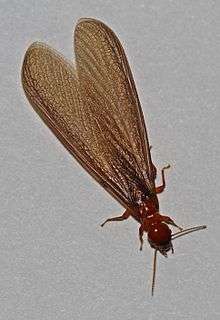Archotermopsidae
Archotermopsidae is a family of termites in the order Blattodea, known as dampwood termites, formerly included within the family Termopsidae. They constitute a small and rather primitive family with five extant genera and 13–20 living species.[1][2] They may be a nuisance, but compared to the drywood termites (Kalotermitidae), usually do not cause extensive damage to buildings or other man-made structures. As their name implies, they eat wood that is not dried out, perhaps even rotting, and consequently of little use to humans.
| Archotermopsidae | |
|---|---|
 | |
| Pacific Coast Dampwood Termite, Zootermopsis angusticollis, British Columbia | |
| Scientific classification | |
| Kingdom: | Animalia |
| Phylum: | Arthropoda |
| Class: | Insecta |
| Order: | Blattodea |
| Superfamily: | Blattoidea |
| Family: | Archotermopsidae Engel et al., 2009 |
| Genera | |
|
Archotermopsis | |
Taxonomy
In 2009, the five extant genera from the family Termopsidae (Archotermopsis, Hodotermopsis, Porotermes, Stolotermes, and Zootermopsis) were moved to a newly created family, Archotermopsidae[3][4][5] (Zootermopsis had previously been treated as part of the family Hodotermitidae)[6], so that the family Termopsidae now includes only fossil taxa: Asiatermes, Huaxiatermes, and Mesotermopsis (Early Cretaceous of China); Cretatermes carpenteri (Upper Cretaceous of Labrador); Lutetiatermes prisca (Upper Cretaceous amber of France); Paleotermopsis oligocenicus (Upper Oligocene of France); Parotermes insignis (Oligocene of Colorado); and Valditermes (incertae sedis).[3][4][1] The genera Porotermes and Stolotermes were later placed into a separate family, Stolotermitidae.[7]
References
- "Archotermopsidae Family Information". BugGuide.net. Retrieved 2018-03-26.
- "Archotermopsidae Overview". Encyclopedia of Life. Retrieved 2018-03-26.
- Engel, M.S.; Grimaldi, D.A.; Krishna, K. (2009). "Termites (Isoptera): their phylogeny, classification, and rise to ecological dominance". American Museum Novitates. 3650: 1–27.
- Constantino, Reginaldo (2016). "Termite Database".
- "Tree of Life Web Project, Termopsidae, Dampwood termites". 2003.
- Arnett, Ross H. Jr. (2000). American Insects: A Handbook of the Insects of America North of Mexico (2nd ed.). CRC Press. ISBN 0-8493-0212-9.
- Engel, Michael S. (2011). "Family-Group Names for Termites (Isoptera), redux". ZooKeys (148): 171–184. doi:10.3897/zookeys.148.1682. PMC 3264418. PMID 22287896.
Further reading
- Atkinson, T.H.; Koehler, P.G.; Patterson, R.S. (1991). "Catalog and atlas of the cockroaches (Dictyoptera) of North America north of Mexico". Misc. Publ. Entomol. Soc. Amer. 78: 1–86. ISBN 978-9991575872.
- Beccaloni, George W.; Eggleton, Paul (2011). Zhang, Z.Q. (ed.). "Order Blattodea Brunner von Wattenwyl, 1882. In: Animal biodiversity: An outline of higher-level classification and survey of taxonomic richness". Zootaxa (3148): 199–200. ISSN 1175-5326.
- Beccaloni, George W.; Eggleton, Paul (2013). Zhang, Z.Q. (ed.). "Order Blattodea. In: Animal biodiversity: An outline of higher-level classification and survey of taxonomic richness (Addenda 2013)". Zootaxa (3703): 46–48. ISSN 1175-5326.
- Borror, Donald J.; Peterson, Roger Tory; White, Richard E. (1998). A Field Guide to Insects. Houghton Mifflin. ISBN 978-0395911709.
- Engel, Michael S.; Krishna, Kumar (2004). "Family-Group Names for Termites (Isoptera)". American Museum Novitates (3432). ISSN 0003-0082.
- Gillott, Cedric (1980). Entomology. Plenum Press. ISBN 0-306-40366-8.
- Kellogg, Vernon L. (1905). American insects. H. Holt.
- Majka, C. (2009). "Thomas L. Casey and Rhode Island". ZooKeys. 22: 267–283. doi:10.3897/zookeys.22.93.
- Misof, B.; Liu, S.; Meusemann, K.; Peters, R.S.; et al. (2014). "Phylogenomics resolves the timing and pattern of insect evolution". Science. 346 (763): 763–7. doi:10.1126/science.1257570. PMID 25378627.
External links
- Dampwood Termite Fact Sheet from the National Pest Management Association with information on habits, habitat and prevention
- Potential Impact of Management Alternatives for Dampwood Termites - California Department of Pesticide Regulation